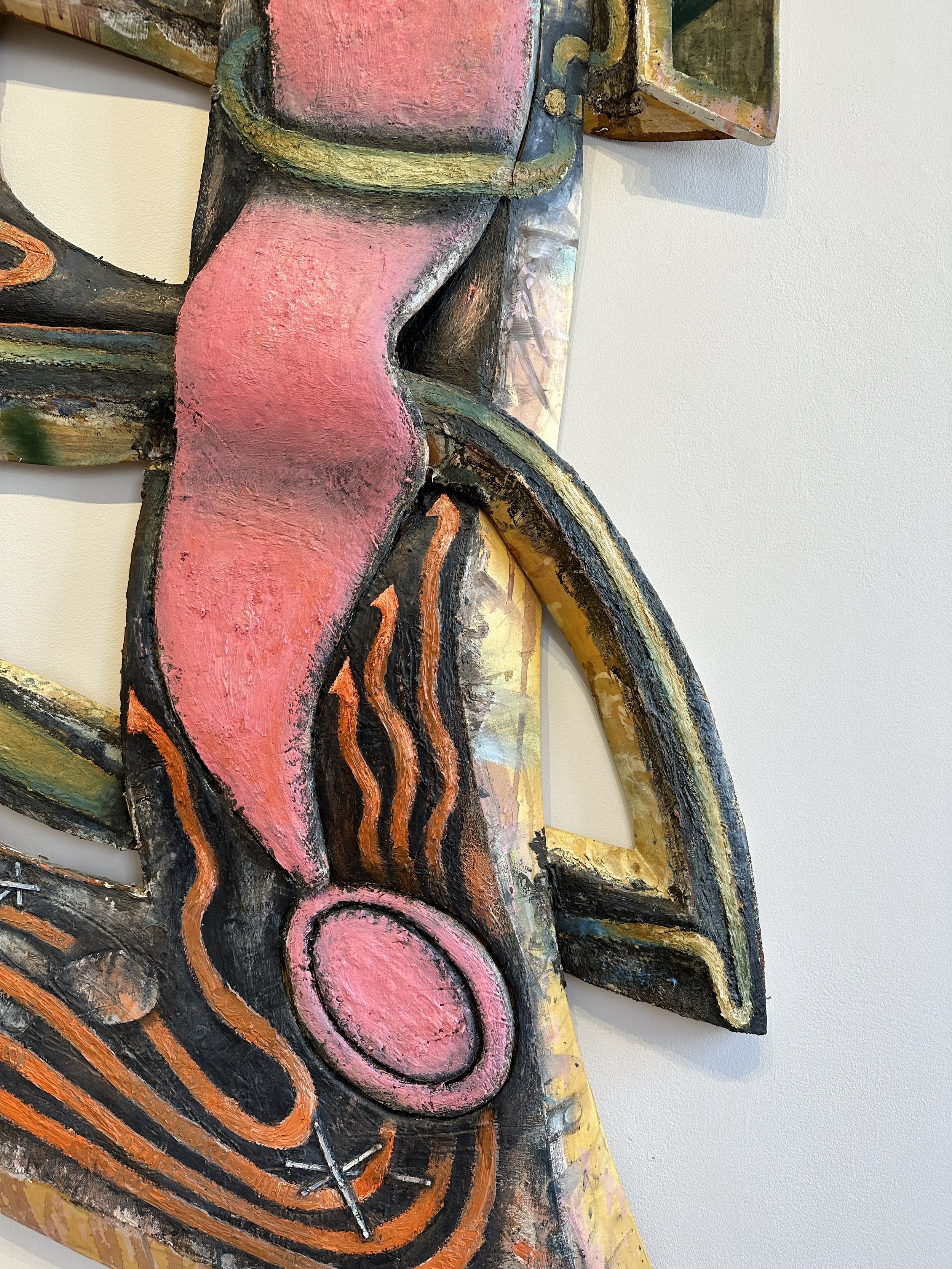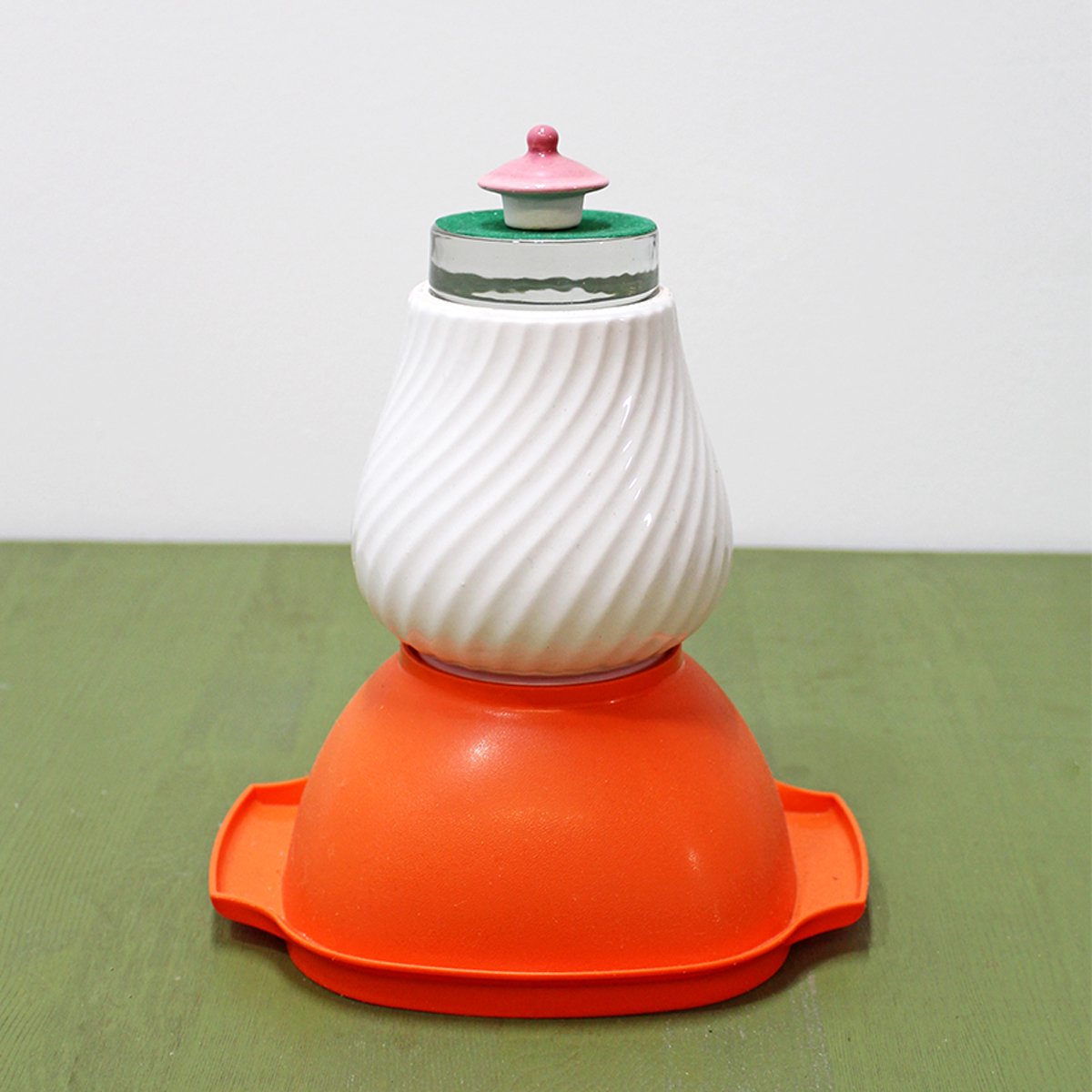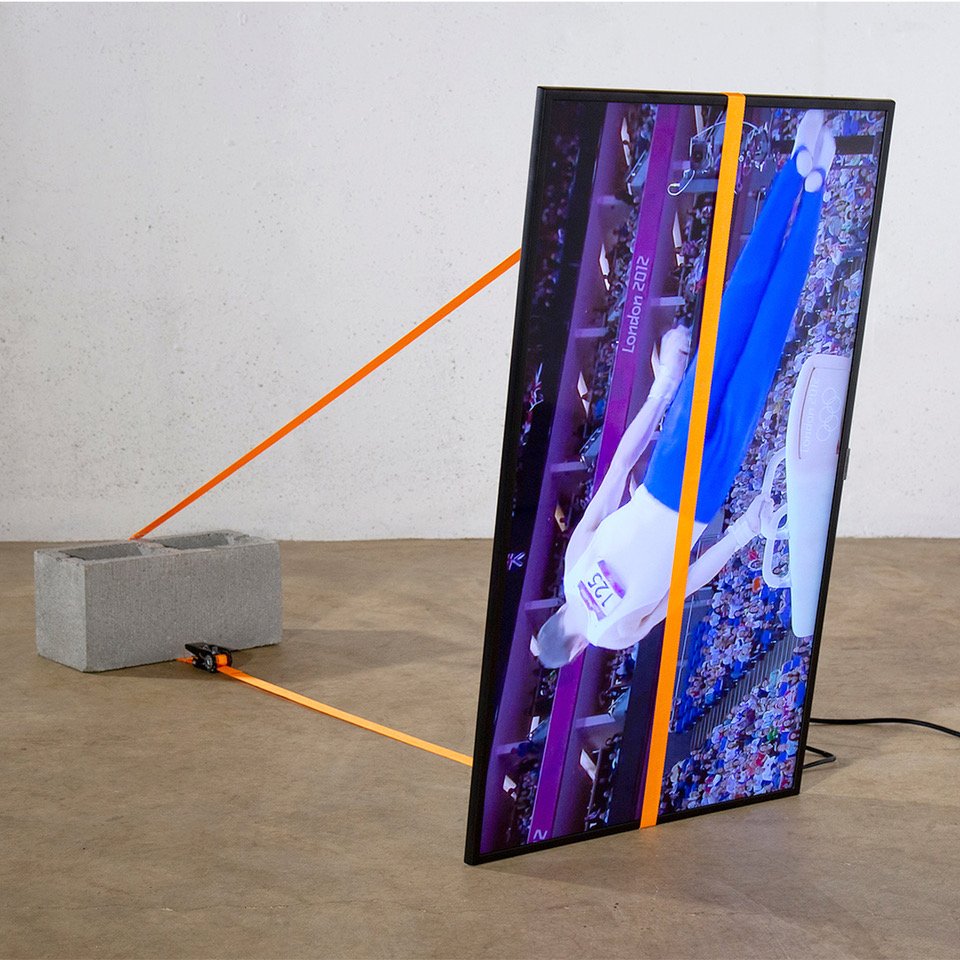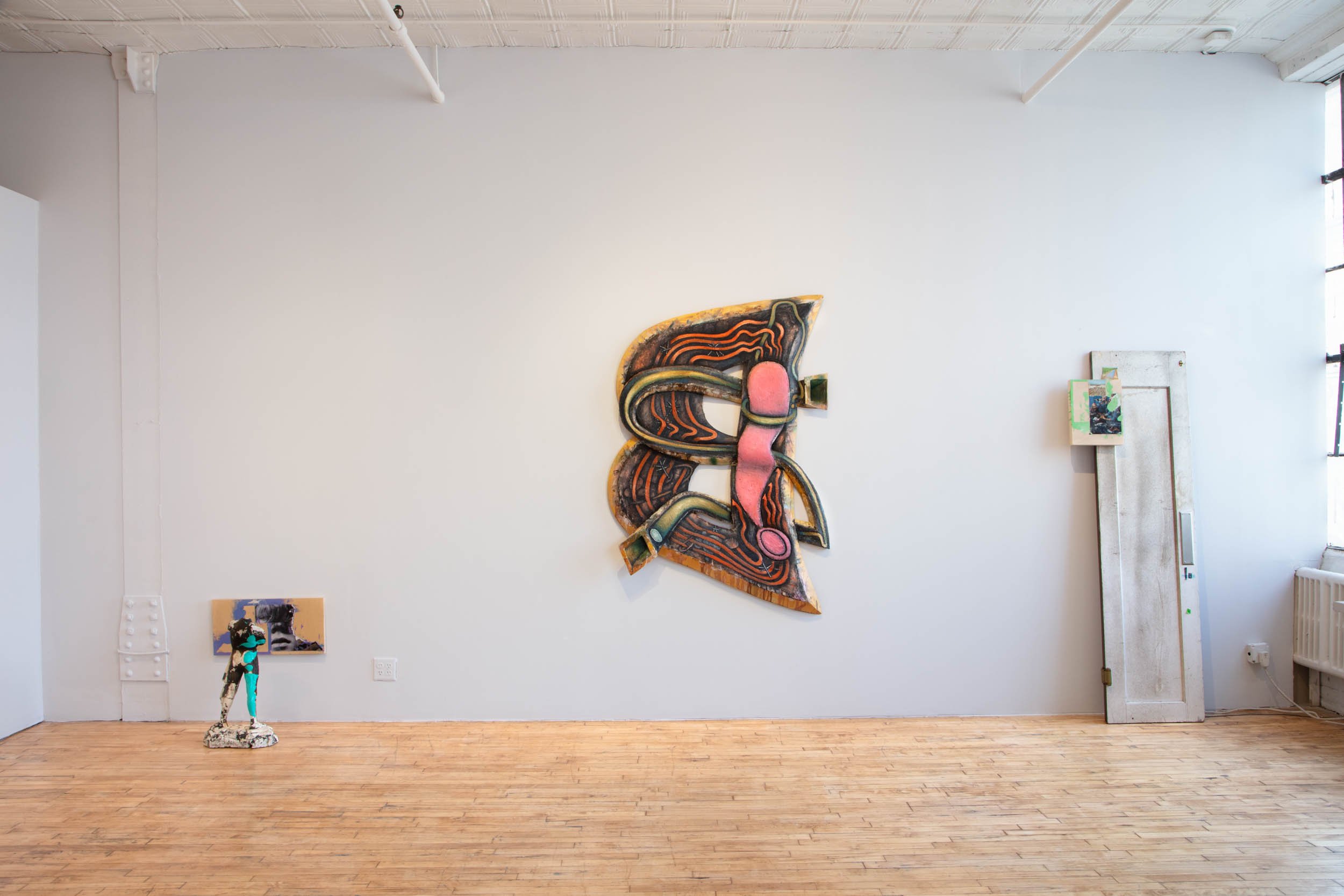Causality: an exhibition curated by Jason Andrew
April 14 - May 14, 2023
Closing event: Sunday, May 14, 3 PM
2. B. ! : a poetic end for “Causality"
Featuring Bob Holman, Elaine Equi, Jerome Sala and others.
Directions: L Train to Brooklyn. Morgan Avenue stop.
Hours: Friday through Sunday, 1 - 6 PM / or by appointment
Causality: when disparate elements are combined or random materials are stacked, when unlikely shapes are forged or incongruent designs are assembled, whether situationally mounted or unconventionally installed, this mishmashing, this mixed-amalgamation incites a new visual equilibrium. Our contemporary world is made up of this dynamism—an unceasing revel of cause and effect.
Artists: Paula Barr, Sarah Bednarek, Ali Della Bitta, Daniel John Gadd, Brece Honeycutt, Ellen Letcher, Trevor King, Elizabeth Murray, Judy Pfaff, Wade Schaming, Christopher Vazquez, Greg Wall
Exhibition Text by Jason Andrew:
6.321 If there were a law of causality, it might be put in the following way: There are laws of nature. But of course that cannot be said : it makes itself manifest.
– Ludwig Wittgenstein in Tractatus Logio-Philosophicus, 1921
We are lucky to live in a time of expanding definitions in art. We celebrate the blending of genres and the mixing of mediums—painting as sculpture, sculpture as painting, sculpture as installation, ceramic as painting, painting and performance, and the vindication of weaving, carving, and craft—any means to visually express the stories of our time.
When disparate elements are combined or random materials are stacked, when unlikely shapes are forged or incongruent designs are assembled, whether situationally mounted or unconventionally installed, this mishmashing incites a new visual equilibrium. Our world is made up of this dynamism—an unceasing revel of cause and effect.
Just 60 years ago, the art world was struggling to understand these new directions. Enforced was the undiluted version of tradition: painting was painting, and sculpture was sculpture. The distinction was so definitive that it elicited the infamous statement from Ad Reinhardt that sculpture was “something you bump into when you back up to look at painting.”
Although Europe had already embraced the art of the assemblage, it wasn’t widely understood here until MoMA mounted “The Art of Assemblage” in 1961. Soon the relationship between two- and the three-dimensional art changed radically. Formally and non-formally, sculpture in particular was “now exploring aesthetic areas either exhausted or rejected by painters,” observed Lucy R. Lippard in 1967. Looking to the West Coast, artists like Wallace Berman, Wally Hedrick, Jay Defeo, Viola Frey, Jess, and Bruce Conner, were free-wheeling in their use of materials, form, and color—embracing a multi-directional art making soon labeled Funk Art.
When the painter Elizabeth Murray arrived in the Bay area in 1961 from Chicago where she explored her own kind of Funk art during undergrad, the stage was set for the genesis of a maverick new rebranding of what painting could do. There in her High Street studio in San Francisco, Murray seized a Dadaistic attitude with vestiges of social protest and a predilection for art as action or event, as well as art as object. The effect was an all-out assault on traditional image making. New notions and possibilities opened up for Murray and after a trip to Pasadena to see the first museum survey of American Pop Art in 1962, she was “very impressed with the attitude, the license, that people like Warhol and Oldenberg took with objects.” Afterward, she began putting “other things” into her paintings.
By the late 1970’s she had all but abandoned the traditional rectangular canvas, opting for one that was eccentric and irregularly shaped. Twisting and skewing her paintings, she advanced painting three-dimensionally and in doing so held a mirror to our frenetic times.
Fast forward two decades and the painting by Elizabeth Murray titled “2. B!”, 1990, sets the defining theme for this show. Its unconventional stretchers, twist and thwack a Shakespearean play-on-words in marquee-size letters; its surface speckled with collaged matchsticks.
In her own distinctive turn, Judy Pfaff straight out of Al Held’s classroom at Yale, took a sculptural approach to painting. “I’m at war with conventions,” Pfaff told Irving Sandler in 1982. Strong color, bold three-dimensional accents, and a strong impulse towards architecture have been the currents driving her art. As I wrote in 2019, Pfaff’s work “conveys a risk-courting adventurousness that is all the more compelling because it edges toward the ephemeral, like performance and indeed life itself. This disposition cuts sharply against the objectness of painting.”
During the 1970’s, Paula Barr (b. 1945, Philadelphia, PA) sought a more engaging experience beyond the rigid, static canvas hanging on a wall. Working in a former sewing factory on Berry Street in Williamsburg, with her neighbor Martin Puryear downstairs, Barr began to lean her stretched canvas panels against the wall and then stacked another on top. “The Leaner Series: Pyrad,” 1974, was among the first works to be realized and was recognized and exhibited by Klaus Kertess at Bykert Gallery. As with each canvas in this series, Barr sought to traverse the large area of the canvas with paint in one commanding and empowering brush stroke. In 1985, with the birth of her son, Barr broadened her palette to include photography and alternative media. As an early practitioner of Cibachrome, she became an innovator in creating site-specific public art installations that melded photography and glass tiles. Her subsequent exploration of architecture, particularly the panoramic views of bridges and skyscrapers of Manhattan, resulted in Barr creating some of the most iconic photographs of New York. Barr studied painting at Boston University graduating with honors in 1967.
Legendary in the early days of the Bushwick art scene, Sarah Bednarek (b.1980, Milwaukee, WI – d. 2019, New York, NY) introduced a drastic shift in her art following a near death emergency surgery where she experienced the sensation of herself hurtling toward a light in a tunnel of kaleidoscopic ever-changing geometric forms. Working sculpturally with wood, power tools, and an indefatigable spirit, Bednarek’s work explores formal relationships such as symmetry, repetition, texture and color through rigorous geometry, craftsmanship, and materials. Humor and the human spirit are captured in her work. Especially in the six-part wall piece “Sunset,” 2019, this work manages to create the “hesitant utopia” she so intensely sought. Bednarek was a 2005 MFA graduate of the Sculpture program at Virginia Commonwealth University and a 2002 BFA graduate of University of Minnesota.
Hailing from the Adirondacks, Ali Della Bitta (b. 1981, New Britain, CT) is inspired by landscape ecosystems in flux and is specifically respondent to the increase of human impact on our natural spaces. These concerns have led to her research in endangered plants, specifically in the Alpine Region of the High Peaks in the Adirondacks. Della Bitta’s most recent “landscaping memory series” stems from these experiences. Primarily using the medium of clay, she accents her sculpture with a range of materials which narrate a contemporary world in flux. These materials include plastic, rubber, epoxy and paint—synthetics that reflect our environmental anxiety. Della Bitta received a BFA from University of North Carolina Greensboro in 2003, and an MFA from Purchase College in 2007.
Brece Honeycutt (b. 1960, Hickory, NC) creates nature and history-based sculpture, drawings, installation, and videos that offer a contemporary lens on traditional forms of making. The exhibition features the work “spinning sessions,” 2008. During the Summer of 2006, and armed with a drop spindle, Honeycutt ventured out to various parks in NYC’s four boroughs. Once inside the parks, she donned her grandmother’s apron, slipped her digital recorder into the pocket, pulled carded wool out of her bag, grabbed her spindle and started to spin. As passersby engaged, she recorded their thoughts and memories many of which involved stories of their mothers and grandmothers. “spinning sessions” is the result of this experience where seemingly disparate materials of homespun wool, audio, and video are combined. Honeycutt holds a BA in Art History from Skidmore College, Saratoga Springs, and an MFA in sculpture from Columbia University, New York.
Daniel John Gadd (b. 1986, River Vale, NJ) makes work that runs the range of human emotion – violent, fragile, sensitive, fierce, and vulnerable, all at once. Gadd’s aesthetic is borne out of the artist’s own life histories, his personal struggles, and his triumph over them. To illicit these emotions, he works painterly while introducing fractured elements of glass and mirror all held together and assembled on wood structures. There is an optimism in the artist’s embedding of mirror—seeking beauty in his humanity as fractured as it may be. The deeper Gadd reaches emotionally, the more visceral and sculptural his paintings become. Gadd holds a BFA from the School of Visual Arts, New York.
Trevor King (b. 1988; Butler, PA) lives and works in New York City. His artworks occur in open-ended projects that ruminate on the endurance of the human spirit. For him the making of an object is a means to articulate the poetic relationships between people, place, history, and the momentary. King grew up in Butler, Pennsylvania, a rust-belt mill town that experienced enormous job loss after the war-time boom. He attributes the post-industrial landscape with his interest in material culture and the resonance of objects. The mundane, the low-brow, and the commonplace inform his imagery, singing with stillness and vacancy. King received a BFA from Slippery Rock University. During this time, he also studied in the Sculpture and Intermedia departments at the Academy of Fine Arts in Poznan, Poland. Trevor received an MFA from the Stamps School of Art & Design at the University of Michigan in 2015.
Ellen Letcher (b. 1972, Willoughby, OH) is a painter, assemble-ly maker, collage maker, and curator. She is fascinated by essentially the unreality of the mind—our struggle for our authentic self, obscured by fashion or driven by propaganda. Through a process of collage, each work for Letcher is a diary of this mêlée. In a blunt juxtapose of paint and sculpture, gesture and collage, Letcher creates combined physical representation of these clashes as they are instigated and re-remembered. Letcher received a BFA with concentration in photography from Jacksonville University, FL. In 2018, Letcher and her partner Julie Torres took the reins at LABspace gallery, Hillsdale NY.
Elizabeth Murray (b. 1940, Chicago, IL – d. 2007, Granville, NY) was an artist at the forefront of American painting for five decades and is considered one of the most important postmodern abstract artists of her time. Her drive and determination produced a singularly innovative body of work characterized by a Cubist-informed Minimalism and streetwise Surrealism. Throughout her career, she reveled in the physicality of paint and approached her work through the constructive vocabulary of sculpture, warping, twisting, splintering, and knotting her canvases. In her innovative and deeply imaginative body of work, Murray not only reclaimed the medium of paint as her own but shared personal evocations of birth and death, laughter and confusion, fullness and loss. The Estate of Elizabeth Murray is represented by Gladstone Gallery, New York, Brussels.
Judy Pfaff (b. 1946, London, UK) is internationally celebrated for her pioneering, maximal installations of dense materiality and soaring ethereal structure, establishing her as a master of contemporary site-specific work. Pfaff has continued to create intricate, expansive installations, while also working in collage, print, sculpture, and paint to explore and illuminate the infinite geometric considerations of physical space via visual and tactile presentation. Her work was included in the Whitney Biennials of 1975, 1981, and 1987. Pfaff additionally exhibited in the Venice Biennales of 1982 and 1984 and represented the United States in the 1998 Sao Paulo Biennale. Her pieces reside in the permanent collections of MOMA, Whitney Museum of Art, Tate Gallery, Brooklyn Museum of Art, and Detroit Institute of Arts, among others. She is the recipient of many awards including the Lifetime Achievement Award from the International Sculpture Center (2014), the MacArthur Foundation Award (2004), and the Guggenheim Fellowship (1983).
Wade Schaming (b. 1984, Pittsburgh, PA) conscientiously assembles his sculptures solely through processes of stacking. The collected materials remain immediate and unchanged – used as is/found – and are unfixed to each other: as such, he creates delicate juxtapositions perilously balanced, like thought given concrete form. From discarded and forgotten objects, which memorialize hope, the assembled forms aspire to return dignity to the bearer and evoke empathy in the viewer. His process is site-specific and confined to the present moment: because he works only with found and discarded materials (nothing is purchased), his pieces reflect their origins while reinforcing a desire to create impermanence. Schaming holds a BA from the University of Pittsburgh and an MFA from the School of Visual Arts, New York. Residency awards include Yaddo, Saltonstall Foundation for the Arts, and The Edward F. Albee Foundation.
Christopher Vazquez (b. 1983, Miami, FL) is known for his multimedia work incorporating photography, video, light, sound and sculpture that draws inspiration from cultural memory and the human condition. This video loop is a part of a series created during the pandemic. The elements in this piece are playfully arranged to create a juxtaposition of tension and balance to invoke a sense of harmony in the weight of chaos. Vazquez is a graduate of the New World School of the Arts in Miami where his experimentation with photography, video and sound developed into a concentration in electronic inter-media studies. His pieces have been presented by various institutions including The Museum of Contemporary Art, North Miami, The Bass, Miami, and The Pérez Art Museum, Miami.
Greg Wall (b. 1989, Long Island, NY) playfully collages together household materials, homemade felt, and traditional art materials into three dimensional sculptures and paintings. His densely layered surfaces experiment with the legibility of abstraction and address the absurd maximalism of commodity culture. In an altruistic effort of reclamation, Wall is guided by improvisation and a sense of play. His work pokes fun at the promise of life made better by consumerism and organization. The tactile nature of the work offers an antidote to the flatness of screen culture and the polished facades with which we compare our own experience. Wall is a recent graduate of the Hunter College MFA program and lives and works in Brooklyn. Prior to Hunter, he worked in the New York gallery and auction world after attending the University of Pennsylvania.
About the curator: Jason Andrew is an independent scholar, curator, producer and founding partner at Artist Estate Studio, LLC—the entity that represents the Estates of Jack Tworkov and Elizabeth Murray among others. Guarding against special interests in any specific style or genre, his curatorial projects bridge gaps left in art history and celebrate both the individual and collective creative imagination through paintings, poetry, and performance.
Press:
Press release
Photos by John Verney




















